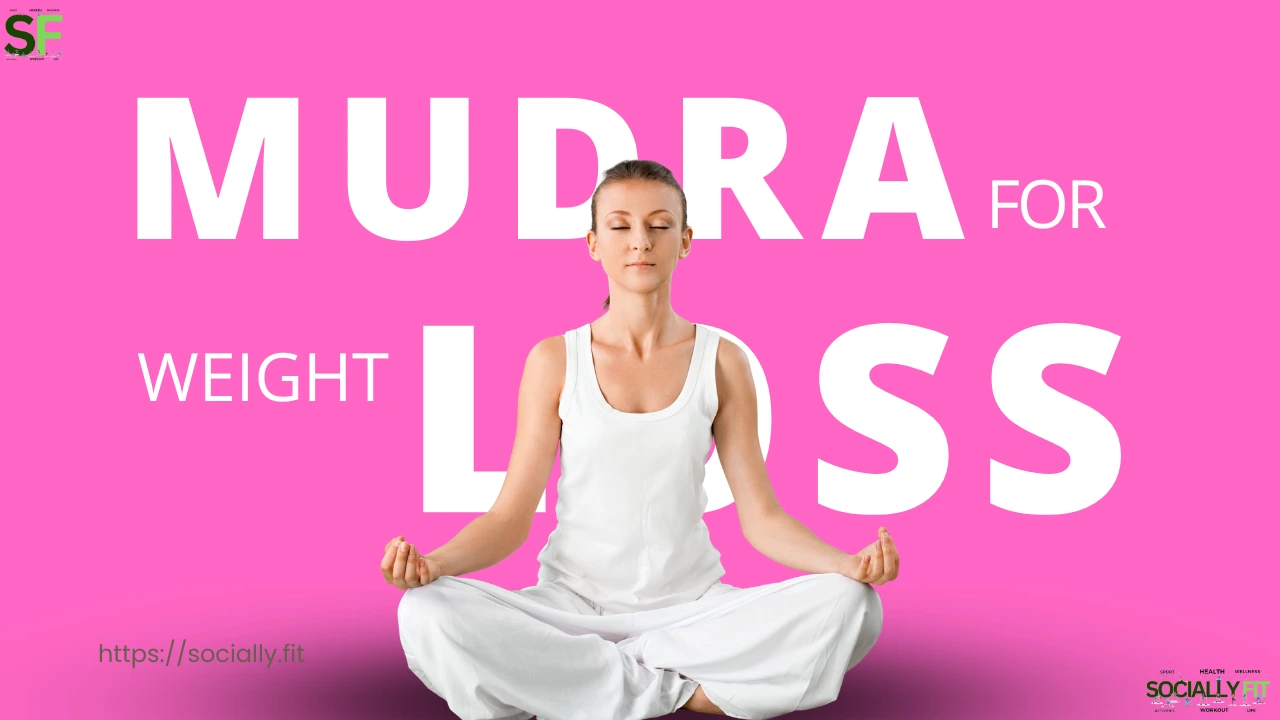Mudra for Weight Loss. Learn how mudras can aid in weight loss through energy flow and mindfulness. Discover types of mudras, their scientific backing, and tips for beginners to effectively incorporate them into your routine.
Introduction: Mudra for Weight loss
In today’s fast-paced world, weight loss often seems like a daunting challenge. Despite the myriad of diets and exercise regimes available, many individuals continue to struggle. However, a holistic approach to weight loss might just hold the key to success. By incorporating mudras—specific hand gestures—into your daily routine, you may find a powerful ally in your weight loss journey. This article explores the fascinating connection between mudras and weight loss, equipping you with the knowledge to harness their potential.
Mudra for Weight Loss
Understanding Mudras

What are Mudras?
Mudras are symbolic hand gestures used in various spiritual and healing practices, particularly in yoga and meditation. Each mudra has its unique significance and is believed to influence the body’s energy flow, thereby promoting physical, mental, and emotional well-being. By using these hand positions, practitioners can channel their energy more effectively, enhancing their meditation experience and fostering a deeper connection to their inner selves.
The practice of mudras dates back thousands of years and is rooted in ancient Indian traditions. They are often associated with the concept of “prana,” or life force, which is thought to flow through the body. By forming specific hand gestures, individuals can stimulate different energy pathways, leading to improved health outcomes. As a result, mudras are increasingly being recognized as a valuable tool for various wellness practices, including weight loss.
Mudra for Weight Loss
Types of Mudras
Mudras can be categorized into several types based on their purpose and application. Some are designed to enhance physical health, while others aim to promote emotional balance and spiritual growth. Understanding these categories will help you choose the right mudra for your weight loss goals.
Here are some types of mudras that can aid in weight loss, each accompanied by descriptions:
Prana Mudra
Description: In this mudra, the tips of the thumb, ring finger, and little finger touch, while the index and middle fingers remain extended. It is believed to enhance vitality and energy levels.

Apan Mudra
Description: This gesture involves joining the tips of the thumb, middle finger, and ring finger together while keeping the index and little fingers extended. Apan Mudra aids in detoxification and digestion.

Surya Mudra
Description: The ring finger is folded down to touch the base of the thumb, with the other fingers extended. Surya Mudra is believed to boost metabolism and promote fat burning.

Gyan Mudra
Description: This mudra is formed by bringing the tip of the index finger to the tip of the thumb while keeping the other fingers extended. Gyan Mudra enhances concentration and mental clarity.

Shunya Mudra
Description: In Shunya Mudra, the middle finger is folded down to touch the base of the thumb, with the other fingers extended. It is believed to help alleviate feelings of hunger and curb emotional eating.

Vayu Mudra
Description: This mudra involves folding the index finger and pressing it against the base of the thumb while keeping the other fingers extended. Vayu Mudra can help relieve anxiety and promote a sense of calmness.

Linga Mudra
Description: To form Linga Mudra, interlock the fingers of both hands and keep the right thumb extended upward. This mudra is thought to generate heat in the body and can aid in weight loss efforts.

Buddhi Mudra
Description: The tips of the pinky finger and thumb touch in this mudra, while the other fingers remain extended. Buddhi Mudra is known to enhance communication and self-expression, which can support emotional well-being during weight loss.

Dhyana Mudra
Description: This mudra is formed by placing both hands on your lap with palms facing up and the right hand resting on the left. Dhyana Mudra promotes deep meditation and mental clarity, essential for a successful weight loss journey.

Mudra for Weight Loss
The Science Behind Mudras and Weight Loss
The scientific basis for the effectiveness of mudras lies in their ability to influence the body’s energy systems. Each mudra is thought to stimulate specific energy pathways, allowing for improved physiological functions such as digestion, metabolism, and hormonal balance. As a result, these hand gestures can help create an optimal environment for weight loss by supporting the body’s natural processes.
Moreover, practicing mudras can also lead to enhanced mindfulness and stress reduction. Research has shown that stress can be a significant contributor to weight gain, as it often leads to unhealthy eating habits and hormonal imbalances. By incorporating mudras into your daily routine, you can promote relaxation and emotional balance, thereby making it easier to adopt healthier lifestyle choices.
Mudra for Weight Loss
How to Practice Mudras Effectively

Tips for Beginners
- Start Slowly: Begin with one or two mudras that resonate with you and practice them consistently.
- Create a Routine: Set aside a specific time each day to practice your chosen mudras.
- Focus on Breathing: Combine your mudra practice with deep breathing exercises for enhanced benefits.
- Find a Comfortable Position: Choose a seated position that allows for relaxation and focus.
- Be Mindful: Stay present during your practice, paying attention to the sensations and energy flow in your body.
- Use Visual Aids: Refer to images or videos to ensure you are forming the mudras correctly.
- Practice Regularly: Aim for daily practice, gradually increasing the duration as you become more comfortable.
- Stay Patient: Allow time for results; mudras work subtly over time and require consistency.
- Combine with Other Practices: Integrate mudras with yoga, meditation, or mindfulness exercises for a holistic approach.
- Listen to Your Body: If you experience discomfort, adjust your practice or consult a professional for guidance.
By following these tips, beginners can effectively incorporate mudras into their weight loss journey, unlocking their potential for enhanced well-being and transformation.
Mudra for Weight Loss
Creating a Routine
- Set Clear Intentions: Begin by defining what you want to achieve with your mudra practice. Whether it’s weight loss, stress relief, or improved focus, having clear intentions will motivate you to stick to your routine.
- Choose a Consistent Time: Select a specific time each day to practice your mudras. Consistency helps reinforce the habit, making it easier to incorporate into your daily schedule.
- Create a Comfortable Space: Designate a quiet and comfortable area for your practice. This space should be free from distractions, allowing you to focus entirely on your mudras and breathing.
- Start Small: If you’re new to mudras, begin with just a few minutes of practice each day. Gradually increase the duration as you become more comfortable and confident in your practice.
- Combine with Other Practices: Integrate your mudra practice with other wellness activities, such as meditation or yoga. This combination can enhance the overall benefits and create a more holistic routine.
- Use Reminders: Set reminders on your phone or place sticky notes in visible areas to prompt you to practice your mudras. These cues can help reinforce your commitment to the routine.
- Track Your Progress: Keep a journal to document your practice sessions, noting any changes in your physical or mental state. Tracking your progress can provide motivation and insight into the benefits of your practice.
- Stay Flexible: Life can be unpredictable, so be open to adjusting your routine as needed. If you miss a session, don’t be too hard on yourself; simply return to your practice when you can.
- Incorporate Mindfulness: Focus on your breath and the sensations in your body while practicing mudras. This mindfulness aspect can deepen your experience and enhance the benefits.
- Celebrate Small Wins: Acknowledge your commitment to your routine, no matter how small the progress may seem. Celebrating these wins can boost your motivation and encourage you to continue your practice.
By following these tips, you can create a sustainable routine that allows you to fully experience the benefits of mudras in your weight loss journey and overall well-being.
Mudra for Weight Loss
Incorporating Mudras into Your Lifestyle

Mindfulness and Meditation
Mindfulness and meditation are powerful practices that cultivate awareness and present-moment focus, providing numerous benefits for mental and emotional well-being. Mindfulness involves paying attention to your thoughts, feelings, and bodily sensations without judgment, allowing for a deeper connection to your inner self. This heightened awareness can lead to reduced stress, improved emotional regulation, and a greater capacity for self-reflection. Incorporating mindfulness into daily life encourages individuals to savor experiences, fostering a sense of gratitude and contentment that can significantly impact overall health.
Meditation, on the other hand, is a structured practice that often involves focusing the mind, typically through techniques like breath awareness, visualization, or mantra repetition. This practice allows individuals to quiet the mind, fostering a state of deep relaxation and clarity. Research has shown that regular meditation can lead to a decrease in anxiety, improved concentration, and even positive changes in brain structure. When combined with mindfulness, meditation becomes a powerful tool for personal growth, enabling practitioners to develop greater resilience and emotional balance, ultimately supporting healthier lifestyle choices, including weight management.
Combining Mudras with Other Techniques
Combining mudras with other techniques can amplify their effectiveness and create a holistic approach to wellness. For instance, integrating mudras with mindfulness practices enhances the experience by channeling energy while maintaining focus on the present moment. This combination allows practitioners to deepen their meditation sessions, making the physical gesture of the mudra a focal point for awareness. By doing so, individuals can experience heightened states of relaxation and clarity, facilitating a more profound connection between body and mind.
Additionally, mudras can be effectively combined with yoga, breathing exercises, or even visualization techniques. Incorporating mudras into yoga practice not only enhances physical postures but also enriches the overall experience by aligning energy flow and intention. Similarly, pairing mudras with specific breathing techniques can promote relaxation and support emotional release. By weaving these practices together, individuals can cultivate a comprehensive routine that addresses both physical and emotional aspects of weight loss, ultimately leading to a more balanced and fulfilling journey toward wellness.
Mudra for Weight Loss
How Do Mudras Compare to Traditional Exercise in Terms of Effectiveness for Weight Loss?
| Comparison Factor | Mudras | Traditional Exercise |
|---|---|---|
| Energy Expenditure | Minimal energy expenditure | High energy expenditure |
| Physical Activity | Primarily involves hand gestures | Involves full-body movements |
| Caloric Burn | Limited caloric burn | Significant caloric burn |
| Muscle Engagement | Low muscle engagement | High muscle engagement |
| Accessibility | Can be practiced anywhere | Requires space and equipment |
| Time Commitment | Short practice sessions | Longer workout sessions |
| Mental Focus | Enhances mindfulness and focus | Can improve focus but often physically demanding |
| Stress Reduction | Promotes relaxation and stress relief | Can reduce stress but may increase it during intense workouts |
| Sustainability | Easy to incorporate into daily life | May require motivation and discipline |
| Holistic Benefits | Supports emotional and spiritual well-being | Primarily physical benefits |
Analysis
- Consider Energy Expenditure: While traditional exercise burns more calories, mudras can still contribute to weight loss by promoting mindfulness and reducing stress.
- Focus on Accessibility: Mudras are highly accessible, allowing individuals to practice them anywhere, making them easier to incorporate into daily routines.
- Evaluate Time Commitment: Short sessions of mudras can fit into busy schedules, whereas traditional exercise often requires more time and planning.
- Recognize Mental Benefits: Mudras enhance mental focus and relaxation, which can indirectly support weight loss by reducing emotional eating.
- Sustainability Matters: The ease of practicing mudras regularly can lead to long-term adherence, while traditional exercise may require more motivation.
Mudra for Weight Loss
What Are the Benefits of Using Mudras for Weight Loss Compared to Dietary Changes?
| Comparison Factor | Mudras | Dietary Changes |
|---|---|---|
| Immediate Impact | Gradual effects on weight loss | Often immediate changes in weight |
| Sustainability | Easy to maintain over time | Requires ongoing commitment |
| Physical Effort | Minimal physical effort | Requires planning and preparation |
| Mindfulness | Enhances mindfulness during practice | Can promote mindfulness through conscious eating |
| Stress Management | Reduces stress and emotional eating | Can help manage cravings through healthy choices |
| Accessibility | Can be practiced anywhere | Requires access to healthy food options |
| Holistic Approach | Supports emotional and spiritual well-being | Primarily focuses on physical health |
| Integration with Other Practices | Easily combined with meditation and yoga | Can be integrated with exercise routines |
| Cost | No cost involved | May involve costs for healthy foods |
| Long-Term Benefits | Promotes overall well-being | Can lead to long-term health improvements |
Analysis
- Acknowledge Immediate Impact: Dietary changes often yield quicker results, while mudras provide gradual benefits that support long-term weight loss.
- Focus on Sustainability: Mudras are easier to maintain over time, making them a valuable addition to any weight loss strategy.
- Consider Physical Effort: Mudras require minimal physical effort, making them accessible for individuals with varying fitness levels.
- Emphasize Mindfulness: Both practices promote mindfulness, but mudras specifically enhance mental focus during the practice.
- Evaluate Cost: Mudras are cost-effective, while dietary changes may require investment in healthier food options.
Mudra for Weight Loss
In What Ways Do Mudras Differ from Meditation Practices When It Comes to Supporting Weight Loss?
| Comparison Factor | Mudras | Meditation Practices |
|---|---|---|
| Physical Engagement | Involves hand gestures | Primarily involves mental focus |
| Energy Flow | Directly influences energy pathways | Focuses on calming the mind |
| Duration of Practice | Shorter practice sessions | Often requires longer sessions |
| Accessibility | Can be practiced anywhere | Requires a quiet space |
| Focus on Intent | Specific intentions tied to gestures | General focus on mindfulness |
| Caloric Burn | Minimal caloric burn | No caloric burn |
| Stress Relief | Provides immediate stress relief | Promotes long-term stress management |
| Integration with Other Practices | Easily combined with meditation | Can include mudras as part of practice |
| Mental Clarity | Enhances focus through physical gestures | Improves mental clarity through stillness |
| Holistic Benefits | Supports emotional and spiritual well-being | Primarily focuses on mental well-being |
Analysis
- Recognize Physical Engagement: Mudras involve physical gestures that can enhance the experience of meditation, making them a complementary practice.
- Consider Duration of Practice: Mudras can be practiced in shorter sessions, making them easier to fit into busy schedules compared to longer meditation sessions.
- Evaluate Accessibility: Both practices are accessible, but mudras can be performed anywhere, providing flexibility.
- Focus on Intent: Mudras allow for specific intentions tied to weight loss, while meditation generally promotes a broader sense of mindfulness.
- Acknowledge Stress Relief: Mudras provide immediate stress relief, while meditation focuses on long-term stress management.
Mudra for Weight Loss
How Do the Effects of Mudras on Weight Loss Compare to Other Holistic Practices Like Yoga or Tai Chi?
| Comparison Factor | Mudras | Yoga/Tai Chi |
|---|---|---|
| Physical Activity | Minimal physical activity | Involves full-body movements |
| Caloric Burn | Limited caloric burn | Significant caloric burn |
| Flexibility | Enhances flexibility of the mind | Improves physical flexibility |
| Mindfulness | Promotes mindfulness through gestures | Deepens mindfulness through movement |
| Stress Reduction | Reduces stress and anxiety | Provides relaxation and stress relief |
| Time Commitment | Short practice sessions | Longer practice sessions |
| Accessibility | Can be practiced anywhere | Requires space and sometimes equipment |
| Holistic Benefits | Supports emotional and spiritual well-being | Offers comprehensive physical and mental benefits |
| Integration with Other Practices | Easily combined with yoga and meditation | Can include mudras as part of practice |
| Community Aspect | Typically practiced individually | Often practiced in groups or classes |
Analysis
- Consider Physical Activity: While mudras involve minimal physical activity, yoga and tai chi provide a more comprehensive workout that can lead to greater caloric burn.
- Focus on Flexibility: Mudras enhance mental flexibility, while yoga and tai chi improve physical flexibility, offering different benefits.
- Evaluate Mindfulness: Both practices promote mindfulness, but yoga and tai chi do so through movement, creating a dynamic experience.
- Acknowledge Accessibility: Mudras can be practiced anywhere, making them more accessible than yoga or tai chi, which may require specific settings.
- Recognize Community Aspect: Yoga and tai chi often foster a sense of community, which can enhance motivation and support in a weight loss journey.
Mudra for Weight Loss
What Distinguishes the Various Mudras Used for Weight Loss in Terms of Their Specific Benefits and Applications?
| Comparison Factor | Prana Mudra | Apan Mudra | Surya Mudra | Gyan Mudra | Shunya Mudra |
|---|---|---|---|---|---|
| Primary Benefit | Increases vitality | Aids in detoxification | Boosts metabolism | Enhances concentration | Reduces feelings of hunger |
| Energy Focus | Life force energy | Digestive energy | Fire energy | Mental clarity | Emotional balance |
| Practice Duration | 15-30 minutes | 20 minutes | 15-20 minutes | 30 minutes | 15-30 minutes |
| Physical Engagement | Minimal | Minimal | Minimal | Minimal | Minimal |
| Accessibility | Easy to practice anywhere | Easy to practice anywhere | Easy to practice anywhere | Easy to practice anywhere | Easy to practice anywhere |
| Mindfulness Aspect | Enhances focus on vitality | Focus on detoxification | Focus on energy and warmth | Focus on knowledge and clarity | Focus on emotional awareness |
| Integration with Other Practices | Can be combined with meditation | Can be combined with yoga | Can be combined with yoga | Can be combined with meditation | Can be combined with mindfulness practices |
| Target Audience | Suitable for all | Suitable for those needing detox | Ideal for those wanting to boost metabolism | Great for students and professionals | Beneficial for emotional eaters |
| Long-Term Benefits | Supports overall vitality | Promotes digestive health | Aids in weight management | Improves mental focus | Helps manage cravings |
| Cultural Significance | Rooted in traditional practices | Common in Ayurvedic practices | Associated with sun energy | Linked to knowledge and wisdom | Tied to emotional balance |
Analysis
- Recognize Primary Benefits: Each mudra offers unique benefits, making it essential to choose the right one based on individual needs and goals.
- Consider Energy Focus: Understanding the specific energy each mudra targets can help you select the most suitable one for your weight loss journey. For instance, if you’re looking to enhance digestion, Apan Mudra may be the best choice, while Surya Mudra is ideal for boosting metabolism.
- Evaluate Accessibility: All listed mudras are easy to practice anywhere, making them convenient options for individuals with busy lifestyles. This accessibility encourages consistency, which is key to achieving results.
- Mindfulness Aspect: Each mudra enhances mindfulness in different ways. While Prana Mudra focuses on vitality, Gyan Mudra centers on knowledge and clarity. Selecting a mudra that resonates with your mental and emotional state can enhance your practice.
- Integration with Other Practices: All mudras can be effectively combined with meditation or yoga practices. This integration can deepen the experience and amplify the benefits, making your overall wellness routine more holistic.
- Target Audience: Each mudra caters to different needs. For example, Shunya Mudra is particularly beneficial for individuals struggling with emotional eating, while Prana Mudra supports overall vitality for anyone looking to boost their energy levels.
- Long-Term Benefits: The long-term benefits of each mudra vary, so it’s important to consider your personal goals. For sustained weight loss, combining multiple mudras may yield the best results.
- Cultural Significance: Understanding the cultural significance of each mudra can enhance your practice. For instance, connecting with the roots of these gestures can provide deeper motivation and a sense of purpose.
By considering these aspects, you can effectively harness the unique benefits of various mudras to support your weight loss journey and overall well-being.
Mudra for Weight Loss
FAQ: Mudra for Weight loss
How long should I practice mudras for weight loss?
Aim for at least 15 to 30 minutes daily, depending on your comfort level.
Can mudras replace traditional exercise?
While mudras can support weight loss, they should complement, not replace, regular exercise and a balanced diet.
Are there any risks associated with practicing mudras?
Mudras are generally safe; however, if you experience discomfort, discontinue practice and consult a professional.
How soon can I expect to see results?
Results may vary; however, consistent practice over weeks can lead to noticeable changes in your mindset and energy levels.
Can I combine multiple mudras in one session?
Absolutely! Feel free to explore different mudras together, as long as you remain mindful and focused.
Mudra for Weight Loss
Conclusion: Mudra for Weight loss
In conclusion, mudras serve as a valuable tool for supporting weight loss when integrated into a broader wellness routine that includes mindfulness and meditation. Their ability to enhance energy flow, promote relaxation, and foster emotional balance positions them as a complementary practice to traditional weight loss methods. While mudras may not replace physical exercise or dietary changes, they can significantly contribute to a holistic approach that embraces the mind-body connection. By incorporating these simple hand gestures into daily life, individuals can cultivate awareness and intention, making it easier to achieve their weight loss goals.
As you embark on your weight loss journey, consider incorporating mudras alongside other practices such as mindfulness, meditation, and yoga. This multifaceted approach can create a supportive environment for lasting change and personal growth. Remember, the journey to wellness is not just about physical transformation but also about nurturing the mind and spirit. By embracing the power of mudras, you can unlock new pathways to vitality, balance, and overall well-being, making your weight loss experience more enriching and sustainable.
Click here to know more about weight loss. Subscribe to Workout with Hunar for weight loss and workout videos.
Mudra for Weight Loss















One thought on “Mudra for Weight Loss: Simple Gestures, Big Results”